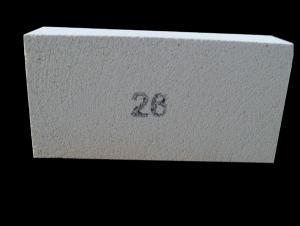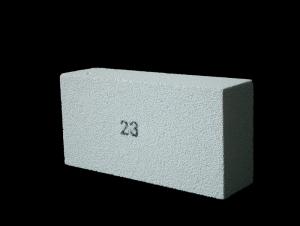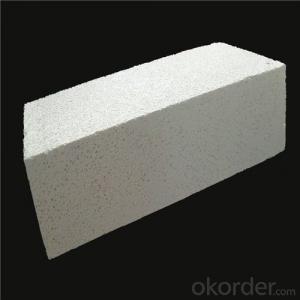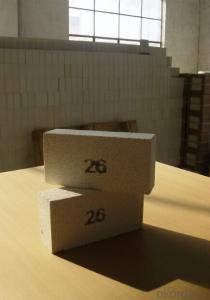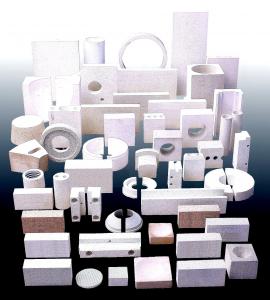Insulating Fire Brick MS23 - High Performance Insulation
- Loading Port:
- China Main Port
- Payment Terms:
- TT or L/C
- Min Order Qty:
- 1000 pcs pc
- Supply Capability:
- 1000 Tons Per Month pc/month
OKorder Service Pledge
OKorder Financial Service
You Might Also Like
General Information of insulating fire bricks MS23
The insulating firebricks temperature is 1260℃(2300℉) and the bricks are manufactured from high purity alumina clay.
Feature of insulating fire bricks MS23
Light weight and low thermal conductivity
Low heat storage
Low iron and impurities
High thermal shock resistance
Application of insulating fire bricks MS23
The insulating firebricks can be used as a hot face lining directly exposed to the heat or as a backup insulation layer in iron and steel mills, non-ferrous foundries, petrochemical, ceramic, glass.
Technical Data of insulating fire bricks MS23
|
| MS23 |
Physical Properties: |
|
|
Classifiction Temperature | ℃ | 1260.0 |
Density | Kg/m3 | 550.0 |
Cold Crushing Strength | Mpa | 1.2 |
Reheating Linear Change(24hrs) |
|
|
1230℃ | % | 0.4 |
Hot Load Strength Deform(90 minutes) |
|
|
1100℃ at 0.034 Mpa(5psi) | % | 0.1 |
Thermal Conductivity |
|
|
400℃ | W/m.k | 0.2 |
600℃ | W/m.k | 0.2 |
800℃ | W/m.k | 0.2 |
1000℃ | W/m.k | 0.2 |
Specific Heat | KJ/Kg.K | 1.1 |
Chemical Analysis: |
|
|
Al2O3 | % | 47.0 |
SiO2 | % | 44.4 |
Fe2O3 | % | 0.9 |
TiO2 | % | 1.2 |
CaO | % | 5.2 |
MgO | % | 0.3 |
Na2O+K2O | % | 1.1 |
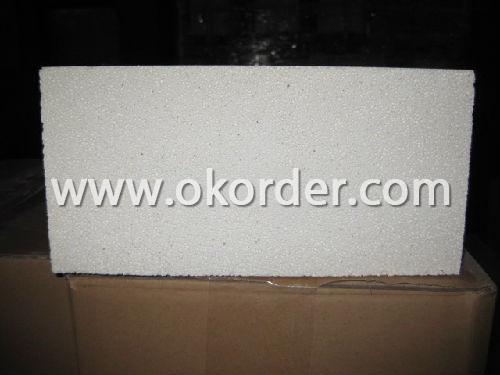
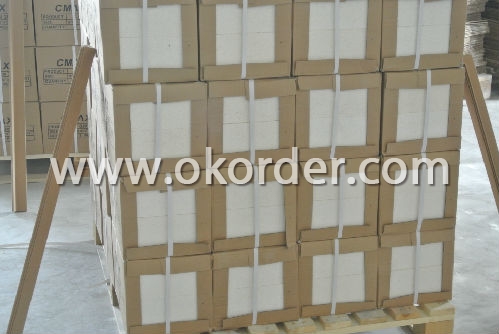
- Q: Can insulating fire bricks be used as a refractory lining material?
- Yes, insulating fire bricks can be used as a refractory lining material. Insulating fire bricks are designed to have low thermal conductivity, which means they can effectively insulate against heat transfer. This makes them suitable for applications where high temperatures need to be maintained or controlled, such as in kilns, furnaces, and industrial ovens. Refractory lining materials are used to protect the structure of these high-temperature environments from the extreme heat generated inside. They need to be able to withstand the thermal shocks, chemical reactions, and mechanical stresses that occur during operation. Insulating fire bricks offer excellent thermal insulation properties, as well as high temperature resistance, making them an ideal choice for refractory lining applications. In addition to their insulating properties, insulating fire bricks also have low density, making them lightweight and easier to handle and install. This can be beneficial in applications where weight is a concern or where refractory linings need to be replaced or repaired frequently. It is important to note that the specific type and composition of insulating fire bricks may vary, and different applications may require different properties. Therefore, it is essential to consult with a refractory engineer or supplier to ensure the chosen insulating fire bricks are suitable for the specific requirements of the application.
- Q: Can insulating fire bricks be recycled?
- Yes, insulating fire bricks can be recycled. These bricks are typically made from a combination of materials such as clay, alumina, and silica, which can be broken down and reused. Recycling insulating fire bricks involves crushing them into smaller pieces and then using them as aggregate in various construction applications. This process helps to reduce waste and conserve resources, making it an environmentally friendly option for disposing of these bricks. Additionally, some companies offer recycling programs specifically for insulating fire bricks, allowing individuals and businesses to easily recycle them instead of sending them to landfills.
- Q: Are insulating fire bricks resistant to thermal conductivity?
- Yes, insulating fire bricks are designed to have low thermal conductivity, which means they are resistant to the transfer of heat.
- Q: Can insulating fire bricks be used in metal melting furnaces?
- Yes, insulating fire bricks can be used in metal melting furnaces. These bricks are designed to withstand high temperatures and provide excellent thermal insulation, making them suitable for use in metal melting furnaces where heat retention is crucial.
- Q: Are insulating fire bricks resistant to corrosion?
- Yes, insulating fire bricks are resistant to corrosion.
- Q: Are insulating fire bricks resistant to salt attack?
- Insulating fire bricks do not typically possess resistance against salt attack, which refers to the deterioration and corrosion of materials caused by salt or saltwater exposure. Although insulating fire bricks are engineered to have exceptional thermal insulation properties, they are not specifically formulated to endure the damaging effects of salt. Salt attack has the potential to weaken the structure of the bricks, leading to a decrease in their performance and durability over time. If these bricks are consistently exposed to salt or saltwater, it is probable that their degradation will be hastened, making them unreliable for long-term use in such environments. To ensure resilience against salt attack, it is advised to utilize refractory materials specially designed for this purpose, such as salt-resistant fire bricks or refractories with a higher alumina content. These materials have been developed to withstand the corrosive impacts of salt and are better suited for applications where exposure to salt or saltwater is anticipated.
- Q: Can insulating fire bricks be used in chemical processing plants?
- Indeed, chemical processing plants can utilize insulating fire bricks. These bricks are specifically engineered to endure elevated temperatures and offer exceptional thermal insulation. Consequently, they are suitable for a wide range of industrial applications, including chemical processing plants. They can be employed to line furnaces, kilns, reactors, and other apparatuses where high temperatures are involved. The exceptional thermal insulation properties of insulating fire bricks aid in reducing heat loss, enhancing energy efficiency, and maintaining a steady temperature within the processing equipment. Furthermore, these bricks exhibit resistance to chemical corrosion and can withstand the rigorous conditions typically encountered in chemical processing plants. Ultimately, insulating fire bricks serve as a dependable and efficient choice for insulating and safeguarding equipment in chemical processing plants.
- Q: Are insulating fire bricks suitable for outdoor use?
- Insulating fire bricks are not typically suitable for outdoor use due to their lower density and higher porosity compared to other types of bricks. These bricks are designed for use in high-temperature applications such as furnaces and kilns, where they provide excellent insulation properties. However, when exposed to the elements, insulating fire bricks may absorb moisture and be prone to cracking or deteriorating over time. For outdoor applications, it is generally recommended to use dense fire bricks or other types of bricks that are specifically designed for outdoor use, as they have greater durability and resistance to weather conditions.
- Q: Can insulating fire bricks be used for both residential and commercial purposes?
- Insulating fire bricks have the capability to serve both residential and commercial purposes. Their design is specifically intended to offer superior insulation and thermal protection, which makes them highly suitable for various applications. In residential environments, these bricks can be utilized to insulate fireplaces, wood-burning stoves, and even pizza ovens, among other possibilities. In commercial contexts, they are widely employed for kilns, furnaces, boilers, and industrial ovens. The widespread applicability of insulating fire bricks contributes to their popularity as a preferred option for projects that demand efficient thermal insulation, regardless of whether they are residential or commercial in nature.
- Q: Can insulating fire bricks be used for insulation in steel mills?
- Yes, insulating fire bricks can be used for insulation in steel mills. Insulating fire bricks are made from lightweight refractory materials that have excellent insulating properties and can withstand high temperatures. They are designed to minimize heat transfer and maintain the desired temperature inside the furnace or kiln. In steel mills, these bricks can be used to insulate the walls, floors, and roofs of the furnaces, ladles, and other equipment. This insulation helps to reduce heat losses, improve energy efficiency, and ensure consistent and controlled heating processes. Additionally, insulating fire bricks can provide thermal stability and protect the steel mill equipment from excessive heat, contributing to longer equipment lifespan and reduced maintenance costs.
1. Manufacturer Overview
| Location | Jiangsu, China |
| Year Established | 2008 |
| Annual Output Value | Above US$ 35 Million |
| Main Markets | Germany; Italy; Turkey; France; England; Japan; Thailand; Vietnam; Idonesia; USA |
| Company Certifications | ISO 9001:2008 |
2. Manufacturer Certificates
| a) Certification Name | |
| Range | |
| Reference | |
| Validity Period |
3. Manufacturer Capability
| a) Trade Capacity | |
| Nearest Port | Shanghai; Qingdao |
| Export Percentage | 10% |
| No.of Employees in Trade Department | 3 People |
| Language Spoken: | English; Chinese; |
| b) Factory Information | |
| Factory Size: | Twenty five thousand tons per year |
| No. of Production Lines | Above 5 |
| Contract Manufacturing | OEM Service Offered; Design Service Offered |
| Product Price Range | High; Average |
Send your message to us
Insulating Fire Brick MS23 - High Performance Insulation
- Loading Port:
- China Main Port
- Payment Terms:
- TT or L/C
- Min Order Qty:
- 1000 pcs pc
- Supply Capability:
- 1000 Tons Per Month pc/month
OKorder Service Pledge
OKorder Financial Service
Similar products
Hot products
Hot Searches
Related keywords
